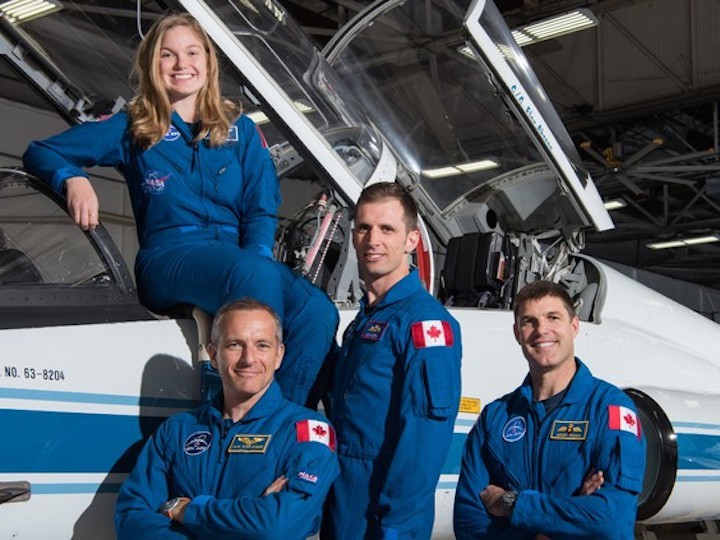18.12.2020
The announcement was made Wednesday by Navdeep Bains, Minister of Innovation, Science and Industry

The Canadian Space Agency astronaut team pictured in 2017. Back: Jenni Sidey-Gibbons. Front, left to right: David Saint-Jacques, Joshua Kutryk, Jeremy Hansen. PHOTO BY NASA/BILL STAFFORD
The next time the United States sends humans to the moon, a Canadian astronaut will be one of them.
The announcement was made Wednesday by Navdeep Bains, Minister of Innovation, Science and Industry. He was joined by Lisa Campbell, president of the Canadian Space Agency, and by astronauts Jeremy Hansen, Joshua Kutryk, David Saint-Jacques and Jenni Sidey-Gibbons. One of the four will be making a trip around the moon.
Expected to launch in August of 2023, NASA’s Artemis 2 will be the first crewed spacecraft to visit the moon since Apollo 17 in 1972. The plan is to launch four astronauts on a journey around the moon, similar to the Apollo 8 mission in 1968. That was followed by the first landing the following year.
The mission will mark the first time humans have left near-earth orbit in more than 50 years. It will also be the first time a Canadian, or any non-American, has ventured into deep space. The International Space Station, which has hosted several Canadian astronauts, most recently Saint-Jacques, orbits about 400 kms above the Earth. The moon is 1,000 times farther out.
Bains spoke of the Apollo 8 mission and the famous photograph of the Earth seen from lunar orbit. “As a Canadian it fills me with pride to think that the next time we see our home planet rising up over the edge of the moon, one of you four will be behind the camera.”
The announcement also highlighted work that Canada is doing on the Lunar Gateway, a proposed space station that will orbit the moon. As part of the Gateway Treaty signed by NASA and the CSA, Canada will build and operate Canadarm3, a next-generation robotic arm, aboard the Gateway. The treaty also guarantees a second lunar flight for a Canadian astronaut, to the Gateway.
“The potential for scientific discovery on the moon with the Lunar Gateway is really exciting,” said Sidey-Gibbons. “From mapping the lunar surface to enabling higher definition images of space. The Apollo program was an amazing program that facilitated some incredible science, and we learned a lot about our own planet and our own moon, but we were limited in the sites that we could visit.”
The Gateway, she said, would also aid in the search for water ice on the lunar surface, a key ingredient for any future sustainable base there.
Kutryk, who said he was “over the moon excited” by the announcement, also noted that Artemis 2 is expected to set a distance and speed record on its trip to the moon and back. “This will be the farthest and fastest that any human in the history of our species has ever gone. I think it’s going to be going Mach 32 when it gets back to Earth, which is scientific speak for really really really fast.” (That’s also 39,000 kilometres an hour, or 11 kms per second.)
The choice as to which astronaut will make the flight is still some ways off, said Campbell. “Canada is fortunate to have a strong corps of highly trained professional astronauts, any one of whom would be an excellent choice.”
But as Hansen noted: “We are paving the way to Canadians doing even more things in space, eventually hopefully one day a Canadian on the moon and on Mars. Those are our goals.”
Quelle: National Post
